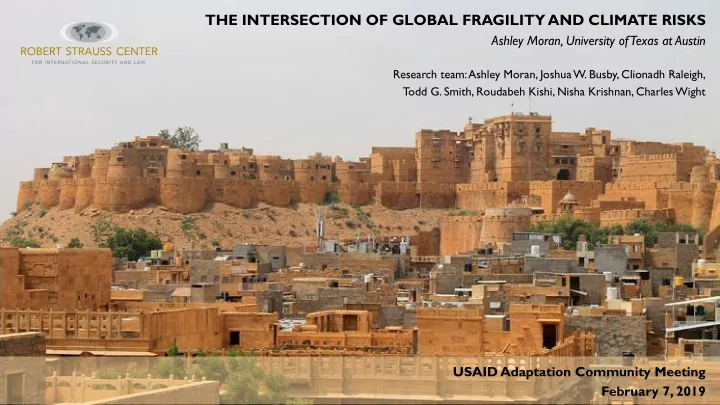

THE INTERSECTION OF GLOBAL FRAGILITY AND CLIMATE RISKS Ashley Moran, University of Texas at Austin Research team: Ashley Moran, Joshua W. Busby, Clionadh Raleigh, T odd G. Smith, Roudabeh Kishi, Nisha Krishnan, Charles Wight USAID Adaptation Community Meeting February 7, 2019
STUDY OVERVIEW ➢ Nexus of fragility and climate risks around the world • First quantitative and mapping effort to assess intersection globally • Builds on G7-commissioned framework on compound risks • Commissioned by USAID/CMM ➢ New measures Climate risks: multiple climate hazards • Fragility risks: state effectiveness and legitimacy in political, security, economic, social spheres • ➢ New portraits of compound risks
CLIMATE RISKS Indicators Used to Assess Exposure to Climate Hazards Climate exposure measure: Busby et al. 2016. Data sources: Global Precipitation Climatology Centre, UNEP/GRID-Europe, Viewfinders Panoramas.
CLIMATE RISKS Cyclones Climate exposure measure: Busby et al. 2016. Data source: UNEP/GRID-Europe.
CLIMATE RISKS Floods Climate exposure measure: Busby et al. 2016. Data source: UNEP/GRID-Europe.
CLIMATE RISKS Wildfires Climate exposure measure: Busby et al. 2016. Data source: UNEP/GRID-Europe.
CLIMATE RISKS Rainfall Anomalies Climate exposure measure: Busby et al. 2016. Data source: Global Precipitation Climatology Centre.
CLIMATE RISKS Chronic Aridity Climate exposure measure: Busby et al. 2016. Data source: Global Precipitation Climatology Centre.
CLIMATE RISKS Low-Elevation Coastal Zones Climate exposure measure: Busby et al. 2016. Data source: Viewfinders Panoramas.
CLIMATE RISKS Climate exposure measure: Busby et al. 2016. Data sources: Global Precipitation Climatology Centre, UNEP/GRID-Europe,Viewfinders Panoramas.
CLIMATE RISKS Climate exposure measure: Busby et al. 2016. Data sources: Global Precipitation Climatology Centre, UNEP/GRID-Europe,Viewfinders Panoramas.
T op 15 Countries or T erritories with Largest Share of Population in Very High Exposure Areas Note: “Very high exposure” areas are four standard deviations or more above the global mean exposure. Data source: Smith, Krishnan, and Busby 2016.
T op 15 Countries or T erritories with Largest Population in Very High Exposure Areas Note: “Very high exposure” areas are four standard deviations or more above the global mean exposure. Data source: Smith, Krishnan, and Busby 2016.
FRAGILITY RISKS Indicators Used to Assess State Fragility Fragility measure: Kishi and Linke 2016. Data sources: Center for Systemic Peace; CIA; Gibney et al.; Kaufmann, Kraay, and Mastruzzi; Miller, Holmes, and Kim; Pilster and Bohmelt; PITF; Marshall, Gurr, and Jaggers; U.S. Committee for Refugees and Immigrants; World Bank; Compilation of armed conflict datasets and consultations with conflict experts.
FRAGILITY RISKS T otal Fragility
FRAGILITY RISKS T otal Legitimacy T otal Effectiveness
FRAGILITY RISKS Changes over Time in T oday’s Fragile States Data source: Kishi and Linke 2016.
KEY COMPOUND RISKS The highest combined fragility-climate risks are in sub-Saharan Africa, followed by MENA and South and Southeast Asia.
KEY COMPOUND RISKS The highest combined fragility-climate risks are in sub-Saharan Africa, followed by MENA and South and Southeast Asia. Climate Exposure in Highest Fragility Countries
KEY COMPOUND RISKS The majority of highly fragile states have more than 1 million people or more than 10% of the population in high-exposure areas. Data sources: Kishi and Linke 2016; Smith, Krishnan, and Busby 2016.
KEY COMPOUND RISKS Most highly fragile states face multiple overlapping climate hazards. Yet a few face high exposure to a single hazard that risks exceeding response capacity. Yemen Mali Niger Republic of the Congo
KEY COMPOUND RISKS State legitimacy is poor in nearly all states with high compound fragility-climate risks.
KEY COMPOUND RISKS Fragility is key in exploring indirect pathways between climate risks and potential conflict outcomes. Varied conflict patterns in Protests and Multiple ongoing similar climate stress riots long-term conflicts
OPPORTUNITIES Group 1: Act now and leverage finance
OPPORTUNITIES Group 2: Identify targeted and prioritized investments
OPPORTUNITIES Group 3: Monitor early and avoid escalation
OPPORTUNITIES Compound fragility-climate risk assessment can: Identify focal points for intervention • • Support early action to prevent new compound risks • Support policy coordination • Develop broadened strategies for reducing fragility Identify the best channels for climate actions in fragile states •
Research team: Ashley Moran Joshua Busby Clionadh Raleigh State Fragility Initiative Director Associate Professor Senior Professor Robert Strauss Center LBJ School of Public Affairs School of Global Studies University of T exas at Austin University of T exas at Austin University of Sussex ashleymoran@utexas.edu busbyj@utexas.edu c.raleigh@acleddata.com T odd G. Smith, Roudabeh Kishi, Nisha Krishnan, and Charles Wight For study reports, data, and maps, see www.strausscenter.org/strauss-articles/state-fragility.html.
Recommend
More recommend